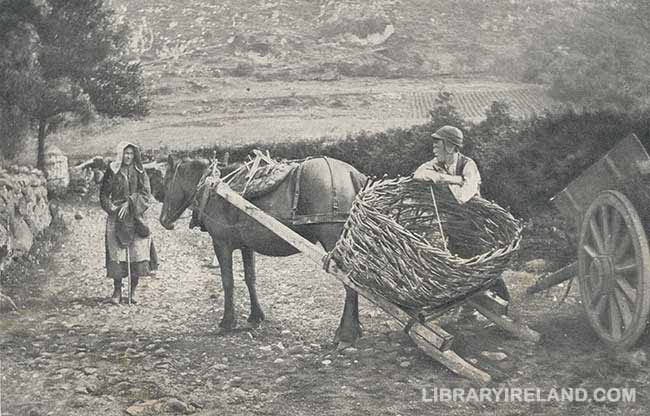Carrick to Donegal
WE put up at the Glencolumbkille Hotel in Carrick. Here we hired a new car, with a stout, white horse to draw it, which took us to the base of Bunglass Head and waited for our return. It is a hard climb of over three miles to reach the summit, over rocks, bog, and heather, but we were well rewarded for our trouble. Bunglass fills the role of a grand-stand, as it were, from which you get a good view of Slieve League Mountain, whose base rises abruptly out of the sea, which breaks against it with great violence. We had heard that the golden eagle builds its nests on this headland, but we did not succeed in finding any of the birds, and concluded that they had flown over to see King Edward's coronation.

A Turf Creel, Carrick, County Donegal
A view of singular magnificence here bursts upon you—a view that of its kind is probably unequalled in the British Isles.
The lofty mountain of Slieve League gives on the land side no promise of the magnificence that it presents from the sea, being in fact, a mural precipice of one thousand nine hundred and seventy-two feet in height, descending to the water's edge in one superb escarpment,
"... around
Whose caverned base the whirlpools and the waves,
Bursting and eddying irresistibly,
Rage and resound forever."
And not only in its height is it so sublime, but in the glorious colors which are grouped in masses on its face. Stains of metalsgreen, amber, gold, yellow, white, red—and every variety of shade are observable, particularly when seen under a bright sun, contrasting in a wonderful manner with the dark-blue waters beneath. In cloudy or stormy weather this peculiarity is to a certain degree lost, though other effects take its place and render it even more magnificent. This range of sea-cliff extends with little variation all the way to Malin, though at nothing like the same altitude.
Having feasted our eyes on the beauties of the precipices, we then ascended, skirting the cliffs the whole way. Near the summit the escarpment cuts off the land slope so suddenly as to leave only a sharp edge with a fearful precipice of above fifteen hundred feet on the side towards the sea, and a steep slope on the landward side. This ledge is termed the "One Man's Path," and is looked on by the inhabitants of the neighborhood in the same light as the Striding Edge of Helvellyn, or the Bwlch-y-Maen of Snowdon. There is a narrow track or ledge on the land slope a little below this edge, facetiously called "The Old Man's Path" by the guides. At the very summit are the remains of the ancient oratory of St. Hugh McBreacon. The view is wonderfully fine; southward is the whole coast of Sligo and Mayo, from Benbulbin to the Stags of Broadhaven; while farther in the distance are faintly seen Nephin, near Ballina, and Croagh Patrick Mountain at Westport. Northward is a perfect sea of Donegal mountains, reaching as far as Slieve Snaght and Errigal, with all the intervening ranges near Ardara, Glenties, and Dunloe.
Coming down was almost as bad as going up had been, but we finally reached our car and were driven home for a late dinner. On the way we were shown the place where Prince Charlie the Pretender embarked when he fled from the English forces.
Read "On an Irish Jaunting Car through Donegal and Connemara" at your leisure
Read On an Irish jaunting Car through Donegal and Connemara at your leisure and help support this free Irish library.
Samuel Gamble Bayne was born in Ramelton, County Donegal, and educated at Queen's University in Belfast. At the age of twenty-five he left for America with a view to making his fortune. He invested in an oil well in Pennsylvania and later founded a bank which subsequently came to be the JP Morgan Chase bank in New York. By the time this book was written he was wealthy enough to be referred to as a billionaire. His account of the tour through the north, west and south of Ireland is a pleasant snapshot of how that part of the country was in the early part of the 20th century. He describes what is to be seen, gives some background history and, through the illustrations especially, provides wonderful glimpses of the area's social history.
The ebook is available in .mobi, .epub, and .pdf formats. See details ».

